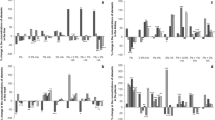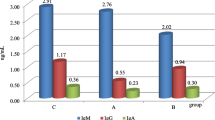Abstract
Aquatic weeds from Cayuga Lake in New York were included as 10% or 20% dry weight of rations which were fed to growing pigs for 69 days. The animals gained weight at a rate comparable to those on a basal diet or a diet in which an equivalent weight of alfalfa replaced the aquatic plants. The feed efficiency (kg ration consumed/kg wt gained) of the aquatic rations was significantly lower, probably because of the lower nutritive value of the aquatic plants. Polychlorinated biphenyls (PCBs) were found in the aquatic plants (0.59 ppm, dry weight) and in the pig fat of those fed the aquatic ration. Hepatic microsomal mixed function oxidase activity was not significantly different in the animals fed the various treatment rations. Histopathologic examination of animal tissues revealed no lesions or abnormalities which could be attributed to the diets.
Similar content being viewed by others
References
Anonymous: IGT weighs potential of fuels from biomass. Chem. and Eng. News, February 23, 1976.
Anonymous: Pesticide Analytical Manual, Vol. 1, U.S. Dept. Health, Education and Welfare, Food and Drug Admin., Washington, D.C., revised, Sections 211.14a and 211.14d, 1971.
Anonymous: Colorimetric determination of phosphatase, acid, alkaline, and prostatic in serum and alkaline in urine. Sigma Tech. Bull. 104, Sigma Chemical Co., St. Louis, MO, 1975.
Bache, C. A., J. W. Serum, W. D. Youngs, and D. J. Lisk: Accumulation of polychlorinated biphenyl residues in Cayuga Lake trout with age. Science177, 1191 (1972).
Baldwin, J. A., J. F. Hentges, Jr., L. O. Bagnall, and R. L. Shirley: Comparison of pangolagrass and water hyacinth silages as diets for sheep. J. Anim. Sci.40, 968 (1975).
Baldwin, J. A., J. F. Hentges, Jr., and L. O. Bagnall: Preservation and cattle acceptability of waterhyacinth silage. Hyacinth Cont. J.12, 79 (1974).
Bates, R. P., and J. F. Hentges, Jr.: Aquatic weeds-eradicate or cultivate? Econ. Botany30, 39 (1976).
Beames, R. M., R. M. Tait, J. N. C. Whyte, and J. R. Englar: Nutrient utilization experiments with growing pigs fed diets containing from 0 to 20% kelp (Nereocystis luetkeana) meal. Can. J. Anim. Sci.57, 121 (1977).
Boyd, C. E.: Fresh-water plants: a potential source of protein. Econ. Bot.22, 359 (1968).
Boyd, C. E.: A bibliography of interest in the utilization of vascular aquatic plants. Econ. Bot.26, 74 (1972).
Byron, H. T., J. F. Hentges, Jr., J. D. O'Connell, and L. O. Bagnall: Organic acid preservation of waterhyacinth silage. Hyacinth Cont. J.13, 64 (1975).
Cameron, C. D. T.: Seaweed meal in the ration for bacon hogs. Canad. J. Agric. Sci.34, 181 (1954).
Conney, A. H.: Pharmacological implications of microsomal enzyme induction. Pharmacol. Rev.19, 317 (1967).
Furr, A. K., A. W. Lawrence, S. S. C. Tong, M. C. Grandolfo, R. A. Hofstader, C. A. Bache, W. H. Gutenmann, and D. J. Lisk: Multielement and chlorinated hydrocarbon analysis of municipal sewage sludges of American cities. Environ. Sci. Technol.10, 683 (1976).
Goering, H. D., and P. J. Van Soest: Forage Fiber Analyses. U.S.D.A. Agric. Handbook No. 379, Washington, D.C. (1970).
Hall, T. F.: Principles of aquatic plant control. In R. L. Metcalf (ed.): Advances in pest control research. Vol. IV, p. 211. New York: Interscience (1961).
Hefiron, C. L., J. T. Reid, W. M. Haschek, A. K. Furr, T. F. Parkinson, C. A. Bache, W. H. Gutenmann, L. E. St. John, Jr., and D. J. Lisk. Chemical composition and acceptability of aquatic plants in diets of sheep and pregnant goats. J. Anim. Sci.45, 1166 (1977).
Hentges, J. F., Jr., R. E. Salveson, R. L. Shirley, and J. E. Moore: Processed aquatic plants in cattle diets. J. Anim. Sci.34, 360 (1972).
Homb, T.: Norges Landbrukshogsk. Furingsforsok Beretn. In W. G. Pond and J. W. Maner (ed.): Swine production in temperate and tropical environments P. 348. San Francisco: W. H. Freeman (1974).
Iwata, Y. and F. A. Gunther: Translocation of the polychlorinated biphenyl Aroclor 1254 from soil into carrots under field conditions. Arch. Environ. Contam. Toxicol.4, 44 (1976).
Kato, R., and J. R. Gillette: Effect of starvation of NADPH-dependent enzymes in liver microsomes of male and female rats. J. Pharmacol. Exp. Ther.150, 279 (1965).
Linn, J. G., R. D. Goodrich, D. E. Otterby, J. C. Meiske, and E. J. Staba: Nutritive value of dried or ensiled aquatic plants. II. Digestibility by sheep. J. Animal Sci.41, 610 (1975a).
Linn, J. G., E. J. Staba, R. D. Goodrich, J. C. Meiske, and D. E. Otterby: Nutritive value of dried or ensiled aquatic plants. I. Chemical composition. J. Animal Sci.41, 601 (1975b).
Lombard, P. E.: Seaweed in the ration of growing baconers. S. African J. Agric. Sci.5, 378 (1962).
Murphy, T. J., and C. P. Rzeszutko: PCBs in precipitation in the Lake Michigan Basin. EPA-600/ 3-78-071. U.S. Environmental Protection Agency, Washington, DC. (1978).
Muztar, A. J., S. J. Slinger, and J. H. Burton: Nutritive value of aquatic plants for chicks. Poultry Sci.55, 1917 (1976).
Nash, R.: The colorimetric estimation of formaldehyde by means of the Hantzsch Reaction. Biochem. J.55, 416 (1953).
Seaquist, R.: Aquatic farms clean up waste water. Popular Science, p. 88 (1977).
Steele, R. G. D., and J. H. Torrie: Principles And Procedures of Statistics. New York: McGraw-Hill (1960).
Stephens, E. L., R. L. Shirley, and J. F. Hentges: Digestion trials with steers fed aquatic plant diets. J. Animal Sci.34, 363 (1972).
Stephens, E. L., J. F. Easley, R. L. Shirley, J. F. Hentges, Jr.: Availability of nutrient mineral elements and potential toxicants in aquatic plant diets fed steers. Proc. Soil and Crop Sci. Soc. Florida32, 30 (1973).
Sutherland, W. W., C. F. Cori, R. Haynes, and N. J. Olsen: Purification of the hyperglycemic-glycogenolytic factor from insulin and from gastric mucosa. J. Biol. Chem.180, 825 (1949).
Sutton, D. L., and W. H. Ornes: Phosphorus removal from static sewage effluent using duck weed. J. Environ. Qual.4, 367 (1975).
Author information
Authors and Affiliations
Rights and permissions
About this article
Cite this article
Yap, T.N., Pond, W.G., Wu, J.F. et al. Nutritional and toxicological studies with growing pigs fed aquatic plant rations. Arch. Environ. Contam. Toxicol. 8, 613–619 (1979). https://doi.org/10.1007/BF01055041
Received:
Revised:
Issue Date:
DOI: https://doi.org/10.1007/BF01055041




